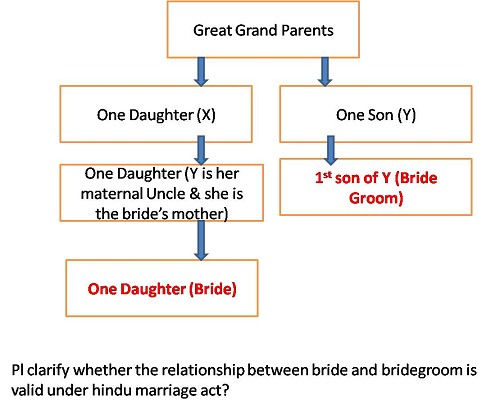Dear Sir,

Please comment on the relationship with reference to the Hindu Marriage Act?
M.N. Gopinath (Asst Manager) 15 March 2010
Dear Sir,

Please comment on the relationship with reference to the Hindu Marriage Act?
Arup Kumar Gupta, Korba, Chattishgarh ((m)9893058429) 15 March 2010
no not valid. bride groom is uncle of the bride.
Kanaksinh P.Boda (Educationist/Lawyer) 15 March 2010
Groom is a son of the mentarnal uncle of the mother of a bride. There are some prominent hindu communities in Maharashtra, where 'mama' (the maternal uncle has a first claim on sister's daughter (bhanji) for his son and thus the father in law is also adressed as 'mama' . Once the maternal uncle issues formal no onjection, the sister choses groom from other source for her daughter, and the opposite is also true. This is not considered to be the same blood as both of them are from different fathers, in patriarch families. However, I have mentioned a tradition and not the law.
M.N. Gopinath (Asst Manager) 17 March 2010
Dear Sir,
Is this a sapinda relationship before the court of law?? Please give your valuable inputs.
Gopinath
Kanaksinh P.Boda (Educationist/Lawyer) 17 March 2010
Same Gotra Marriages are avoided, as I know.
Arup Kumar Gupta, Korba, Chattishgarh ((m)9893058429) 17 March 2010
HINDU MARRIAGES
5. A marriage may be solemnized between any two Hindus, if the following conditions are fulfilled, namely:-
(iv) The parties are not within the degrees of prohibited relationship unless the custom or usage governing each of them permits of a marriage between the two;
(v) The parties are not sapindas of each other, unless the custom or usage governing each of them permits of a marriage between the two.
Sec 2. (f)
(i) "sapinda relationship" with reference to any person extends as far as the third generation (inclusive) in the line of ascent through the mother, and the fifth (inclusive) in the line of ascent through the father, the line being traced upwards in each case from the person concerned, who is to be counted as the first generation;
(ii) Two persons are said to be "sapindas" of each other if one is a lineal ascendant of the other within the limits of sapinda relationship, or if they have a common lineal ascendant who is within the limits of sapinda relationship with reference to each of them;
(g) "degrees of prohibited relationship"-two persons are said to be within the "degrees of prohibited relationship"
(i) If one is a lineal ascendant of the other; or
(ii) If one was the wife or husband of a lineal ascendant or descendant of the other ; or
(iii) If one was the wife of the brother or of the father's or mother's brother or of the grandfather's or grandmother's brother of the other; or
(iv) if the two are brother and sister, uncle and niece, aunt and nephew, or children of brother and sister or of two brothers or of two sisters ;
Explanation.-For the purposes of clauses (f) and (g), relationship includes-
(i) relationship by half or uterine blood as well as by full blood;
(ii) illegitimate blood relationship as well as legitimate; (iii) relationship by adoption as well as by blood ; and all terms of relationship in those clauses shall be construed accordingly.
Suchitra. S (Advocate) 18 March 2010
According to HMA, this relationship does come under sapinda relationship and so, prohibited from gatting married. But if the custom allows such marriages, then the Court will not object to the same.
Sanjeev Panda (Advocate) 25 March 2010
Perfect answer by Suchitra
Adv. Biju Gopal (Advocate FAMILY LAWYERS Kottayam Kerala www.familylawyers.in) 25 March 2010
I agree with Suchitra. S
K.P.Satish Kumar (Advocate) 08 November 2011
There was no legal burden in your marriage. You can proceed.
